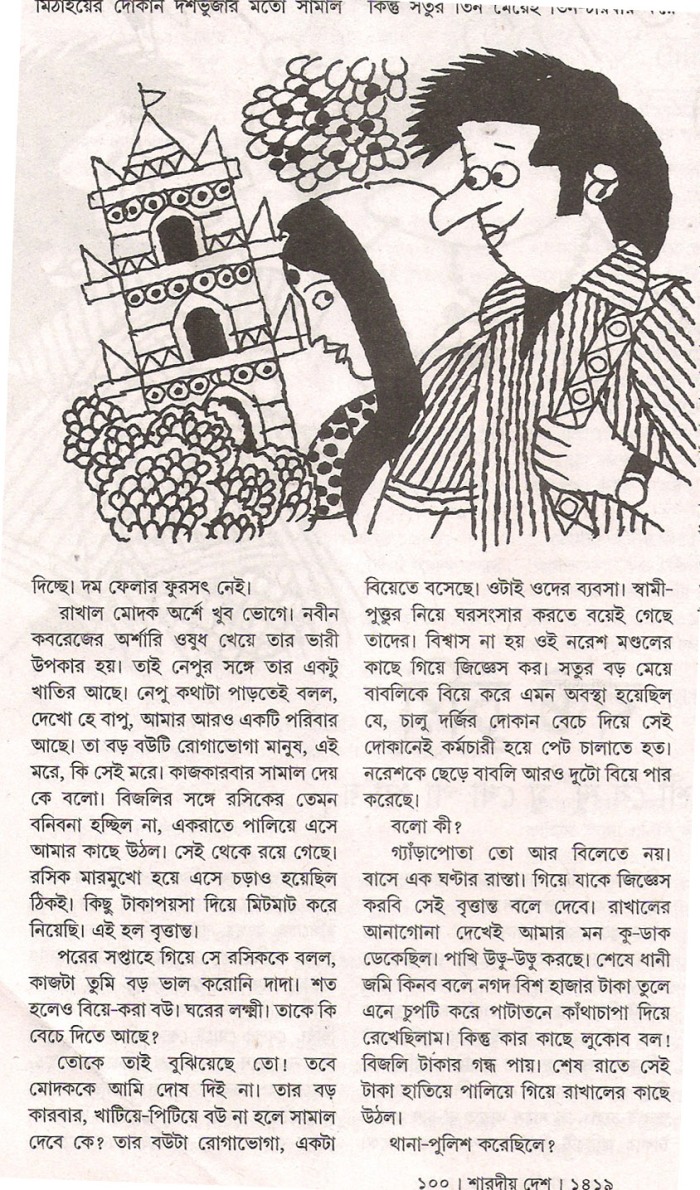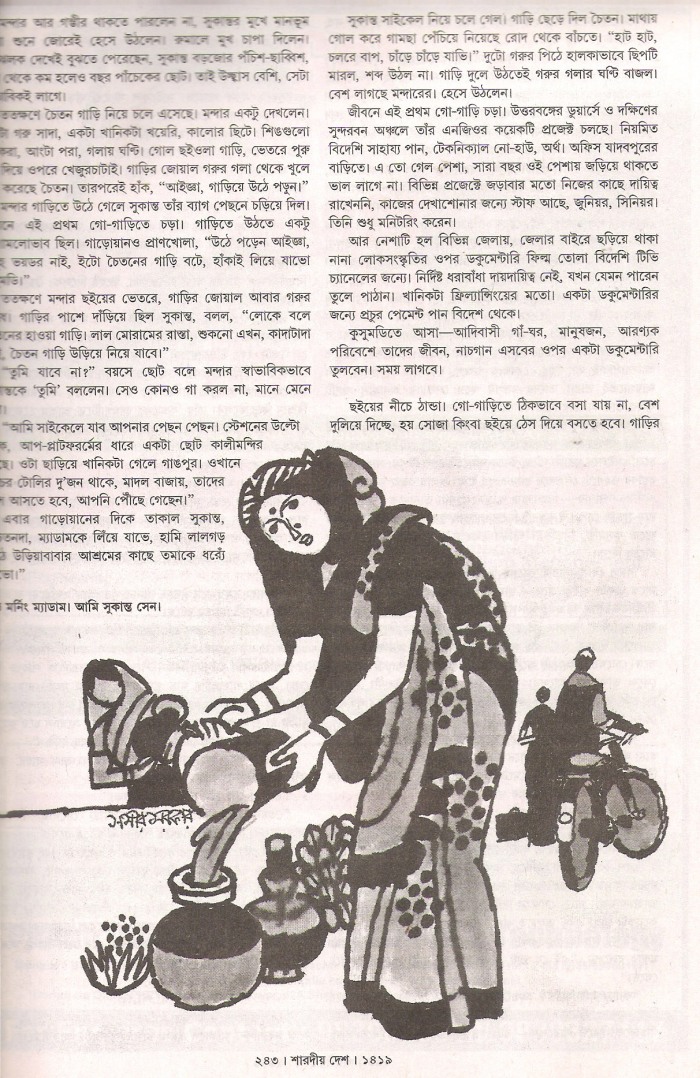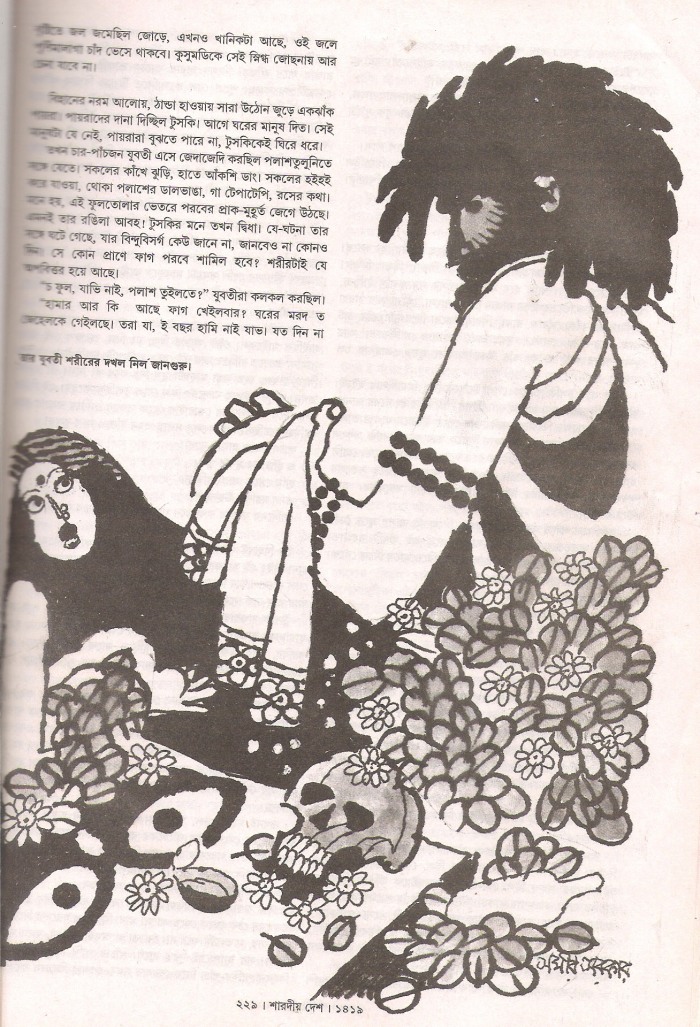In 1976 I joined Clarion Advertising as a Trainee and that was when I met Samirda. Being a hard core Bengali, I was familiar with his style of illustrations which accompanied the novels by famous Bengali authors in the annual numbers of Desh and Ananda Bazar, commonly known as the Sharadiya Shankhas. For me, it was like meeting a celebrity. As it so happened, my role as a fetcher and carrier in my Group (that’s what Trainees do) gave me more opportunities to spend time with him as he was assigned to work on the accounts in our group.
Samirda was a quintessential Bengali. He looked like one, had all the Bengali middle class attitudes and while I didn’t find him to be a football buff like our then Chief Art Director, Kanu Basu, he certainly loved playing cards. He loved his addas and since Urmimala and I were from the same social milieu, we were always welcome to sit and chat with him. He, of course, was a colleague of Urmi’s father and so knew her as a kid.
Samirda’s scribbles were a piece of illustration by themselves. And more often than not, they were good to go for the artwork directly. In fact, it was at times difficult to “photograph” his characters. The models were never the same, nor were the expressions that he sketched. Often, he would get carried away and finish the layout all by himself, even scribbling out the blah blahs that were written out as dummy Body Copies. Though these blah blahs were supposed to be nonsensical letters, I have often tried to read them closely and found that he actually wrote some meaningful stuff, some thrashing the bosses or about some people who he did not like. We found them amusing and before we took his layouts to the client, we would try and make sense of the gibberish he had written!
I have never seen Samirda serious. He always had a smile and the only time he looked serious was when he decided to finish the rough layout all by himself. Or, when he sat with Subodhda, our Typographer, on selecting the font for the ads. Subodhda had once told us that Samirda was very particular about the choice of fonts and was always trying to experiment. We must remember that these were the days before computers or even photo-type settings and in case the font was not available with the vendors, specially Linguaprint, they had be cut, letter by letter, from bromides. Niranjan Kaka, who was an expert in this job would spend the whole day cutting the letters and pasting them to form the Headline. Some said that Niranjan Kaka was by profession a darzee and hence became a specialist cut paste artist!!
He was always proud of telling us that he was hand-picked by Satyajit Ray who, if I remember correctly, was an examiner when Samirda was passing out from Government Art College and he was so impressed by his work that the great man had suggested to the Chairman/MD of Clarion to “bag ‘im!”. I am reproducing an extract from my book Life in a Rectangle which will carry this story further:
Samir Sarkar was the favourite for many of us who were into Bengali literature, religiously reading the annual numbers of Desh and Ananda Bazar Patrika and were conversant with his style of illustration, which accompanied the stories of leading Bangla writers. It was not just his style but also the characters he portrayed, specially women, all of whom had a charm about them. The annual number of Desh always carried a Feluda story written by Satyajit Ray which was also illustrated by him. In 1976, Ray was busy with the post production of Shatranj Ke Khiladi and had told the publishers that since he wouldn’t have the time, they should get Samirda to handle the illustrations. When we heard about it we were very excited and every day we would discuss the finer points of Feluda and Topshe. Urmi and I, both Ray aficionados would sit with him every day and keep discussing what Feluda did in this story and that story. Finally, the story appeared and naturally, we first went through the illustrations before reading the story. We were so proud of him. That was the only time that a Ray story was ever illustrated by someone else. I had also heard that Kanu Basu had done the now famous poster design for Jalsaghar. This one is hearsay, I cannot vouch for it. But I think there is some truth in this.
He was very fond of Urmi, Arun Chaudhuri and me and had once invited us over for lunch to his house. These were the zamana days, and mid-way through the lunch, Boudi had to cook a handi of rice since Arun and I had polished off what was served.
In 1979 Samirda left Clarion to join JWT (then HTA) and in 1982, when I got married, I went to get my wedding card designed by him. As was customary, a few cards were sent to Mumbai where I was getting married and when the train reached Dadar my sister-in-law, Khushi, asked me if I had got the card designed by one Samir Sarkar. The famous painter Milon Mukherjee, who is a friend of the family, had seen one such card and told them that only Samir Sarkar could have done the card.
By the time I returned to Clarion as the Branch Head, Samirda had returned to Clarion and on my first day, I ran up to meet him.
“Ekhon thekey tui amader Boss?” he asked.
I was so ashamed and did not know what to answer till he patted me and gave me a warm smile.
Post Clarion I moved to Delhi and kept up with him once in a while. The last time I spoke to him was when my book was being launched in Kolkata.
“Have you got a publisher?”
“Yes, of course, it is a book launch.”
He said he would try and make it but I did not see him.
Last Tuesday I was checking my Facebook when a chat box from Mrittika popped up, telling me that he had passed away.
In his death we have lost a quite celebrity, a perfect bhadralok, a store house of creative talent and above all, a hero.



